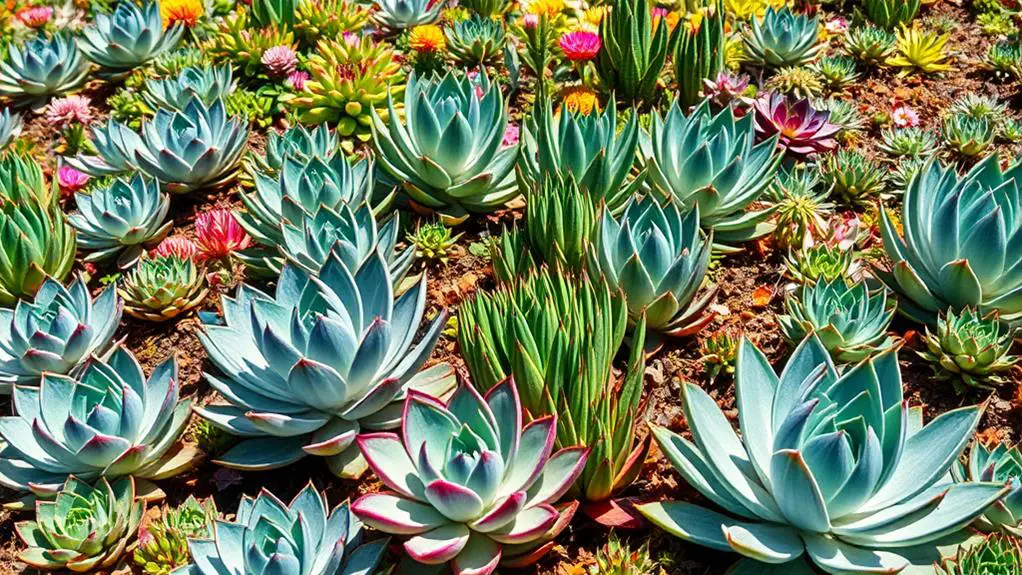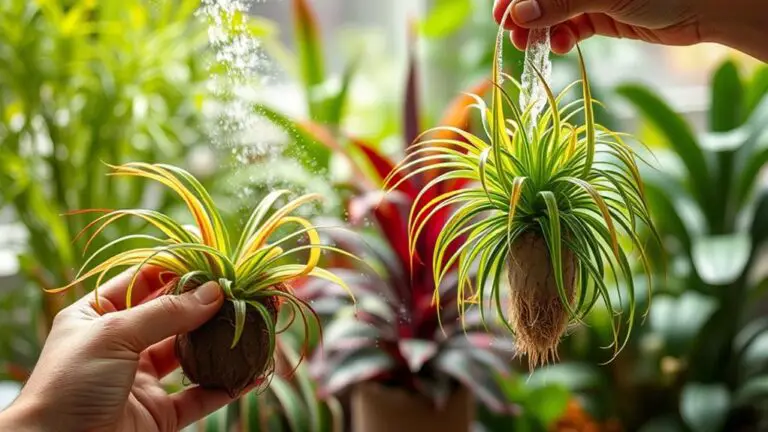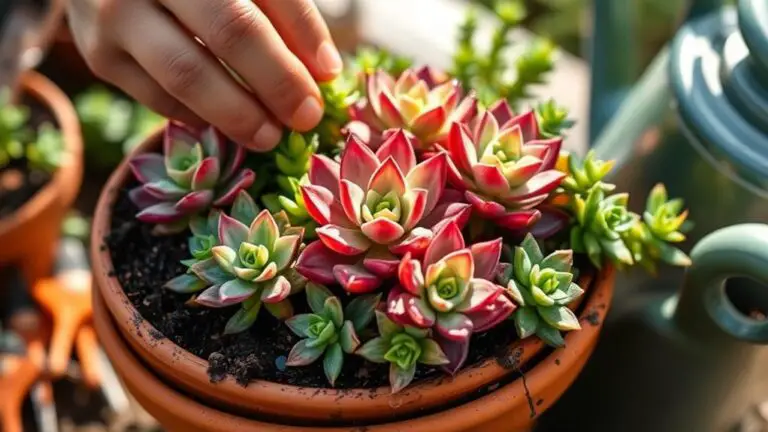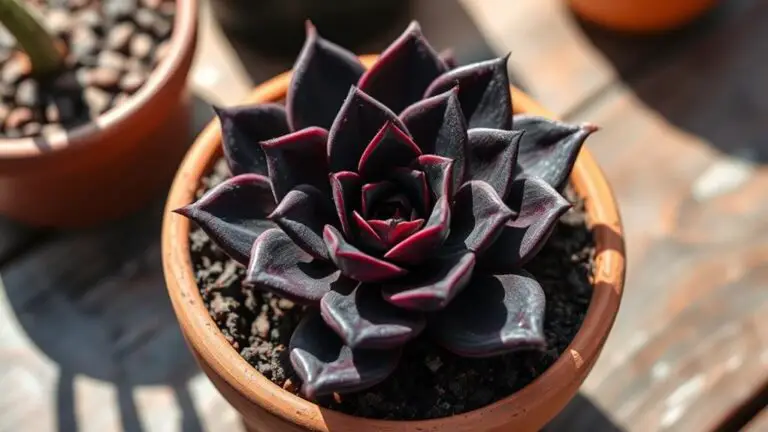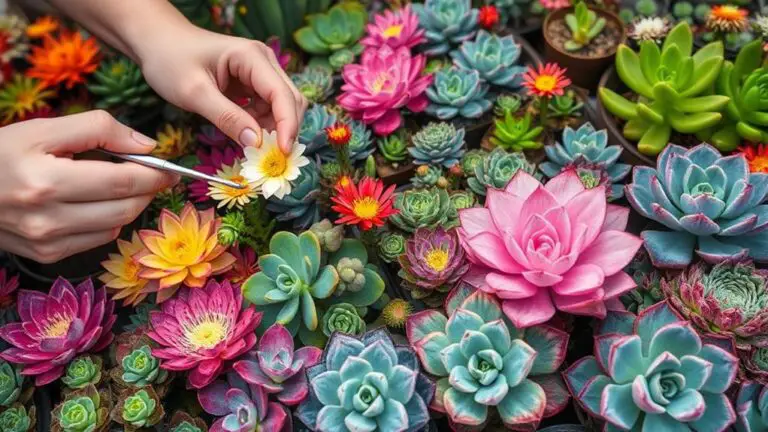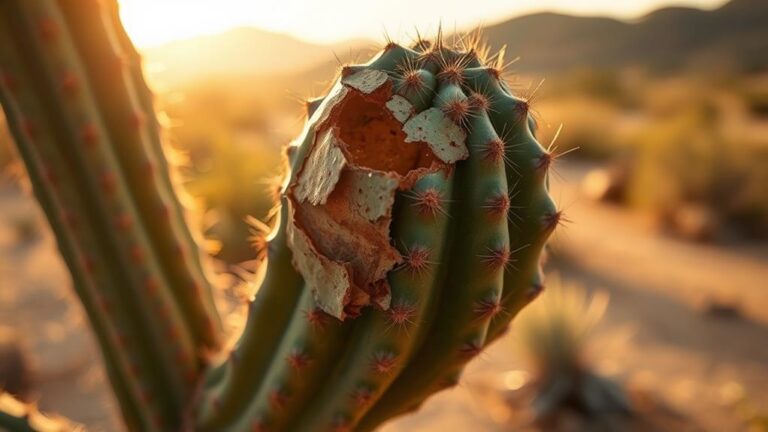10 Best Succulents for Full Sun Exposure
If you're looking to enhance your sunny garden spaces with low-maintenance yet striking plants, succulents are an excellent choice. You'll find that varieties like Sedum Sediforme and Echeveria Lilacina can thrive with at least six hours of direct sunlight each day. But these aren't the only options; there are eight more that offer unique colors and forms. Whether you're aiming for a drought-tolerant garden or simply want to add some robust beauty, the right selection can make all the difference. Ready to discover the rest? Let's take a closer look at what each succulent has to offer.
Sedum Sediforme
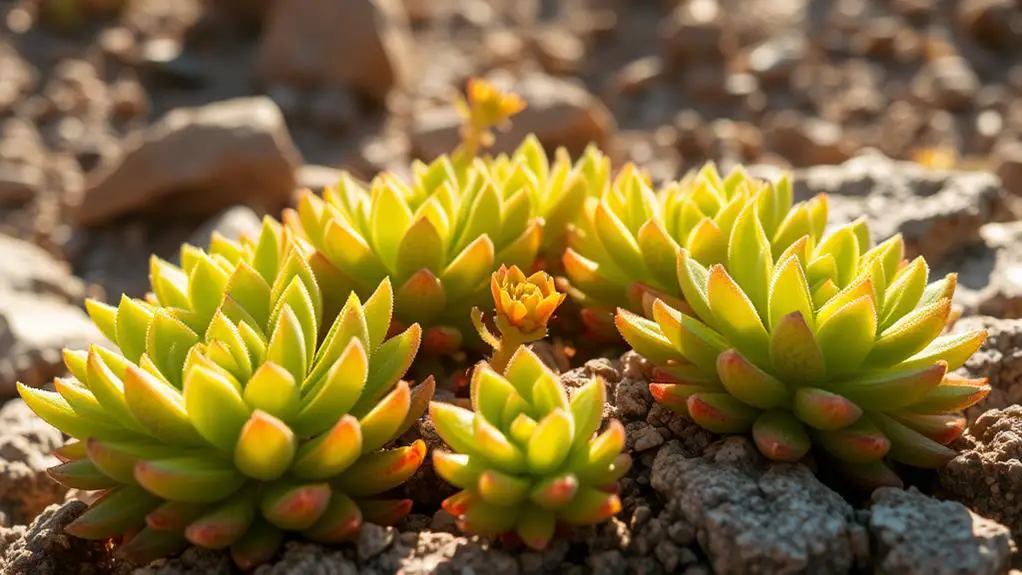
Are you looking for a resilient succulent that thrives in full sun? Search no more than Sedum sediforme, commonly known as Stonecrop. This hardy succulent is perfect for those sunny spots in your garden, as it needs at least six hours of direct sunlight each day.
Sedum sediforme is one of the best full sun plants you can choose. Its fleshy, green to yellow-green leaves form attractive mats or cushions, making it an excellent ground cover. This means it can cover large areas of soil, providing a lush, green look with minimal effort.
Plus, it's low-maintenance and drought-resistant, which makes it ideal for busy gardeners or those new to gardening.
This succulent is highly adaptable to different soil types but prefers well-draining soil to prevent root rot. Whether you have sandy soil or rocky terrain, Sedum sediforme will likely thrive.
It's hardy in USDA zones 5 to 9, so it can withstand both hot summers and cold winters.
With minimal watering needs, this plant is perfect for xeriscaping and rock gardens. You'll find that it's a reliable and beautiful addition to your garden, requiring little care while delivering a lot of beauty.
Echeveria Lilacina
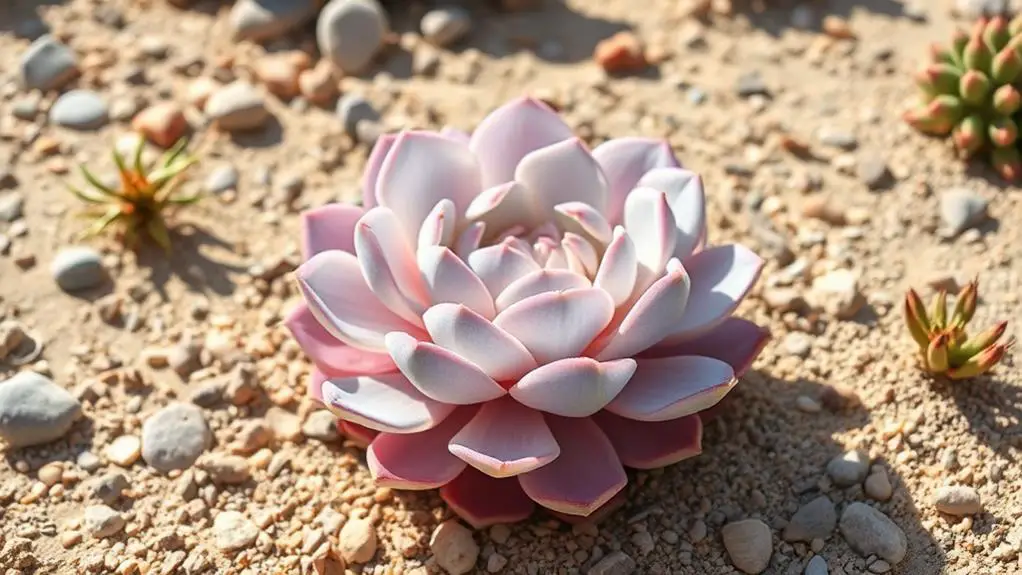
Commonly known as the "Ghost Echeveria," Echeveria lilacina is a stunning succulent that stands out with its rosette shape and soft, powdery leaves. This beautiful plant showcases a lilac hue when exposed to full sun, making it one of the best succulents for bright, sunny spots in your garden.
You'll find that Echeveria lilacina thrives in full sun conditions, needing at least six hours of direct sunlight daily. This guarantees it maintains its vibrant color and grows efficiently. Since it's drought-tolerant, you won't have to water it often, making it perfect for those who might forget to water their plants occasionally.
Just make sure it's planted in well-draining soil to prevent root rot.
This succulent grows moderately, reaching 6 to 12 inches in height and spreading about 12 inches wide. Its size makes it ideal for both container gardening and adding to your landscape design.
If you're in hardiness zones 9 to 11, Echeveria lilacina will do well, though it can handle brief cold spells. However, protect it from frost to keep it healthy and thriving for years to come.
Echinocactus Grusonii
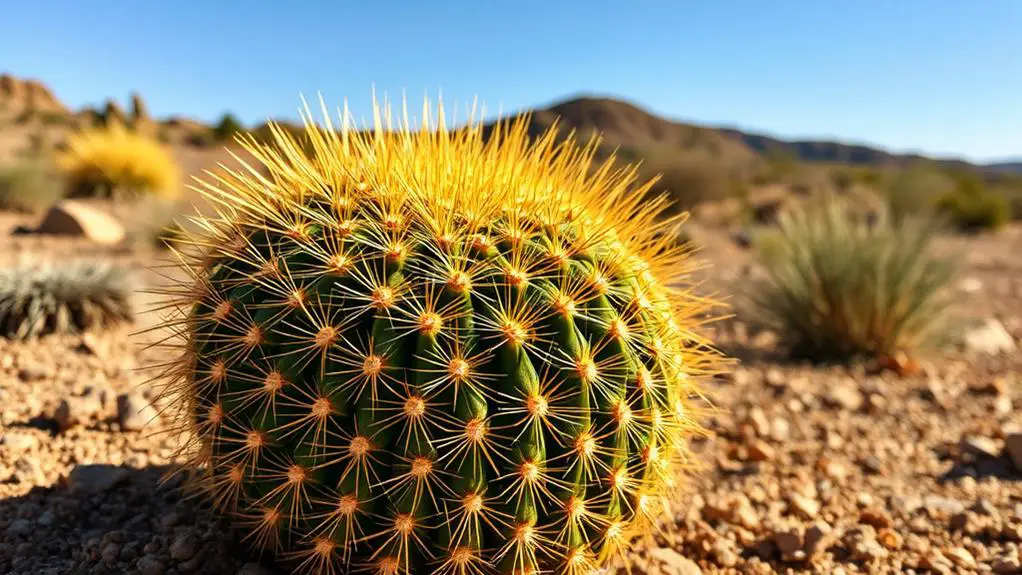
The Golden Barrel Cactus, or Echinocactus grusonii, is a striking succulent that thrives in full sun exposure, needing at least six hours of direct sunlight each day. This cactus is perfect for those sunny spots in your garden where other plants might struggle.
Its round, barrel-shaped body is covered in prominent golden spines, which not only look stunning but also protect it from herbivores and reflect excessive sunlight. Succulents love the sun, and the Golden Barrel Cactus is no exception.
It's drought-tolerant and prefers well-draining soil, making it a low-maintenance addition to your garden. Plus, it can grow up to 2 feet tall and wide, creating a bold statement piece. During the summer, you'll be delighted by its beautiful yellow flowers.
Here are some key points to remember:
- Full Sun Exposure: Needs at least six hours of direct sunlight daily.
- Drought-Tolerant: Ideal for arid environments and low-maintenance gardens.
- Safe for Pets: Non-toxic, making it a safe choice for homes with animals.
Echinocactus grusonii is hardy in USDA Zones 9 to 11. If you're looking for a resilient and eye-catching succulent, this cactus is a fantastic choice!
Graptoveria Fred Ives
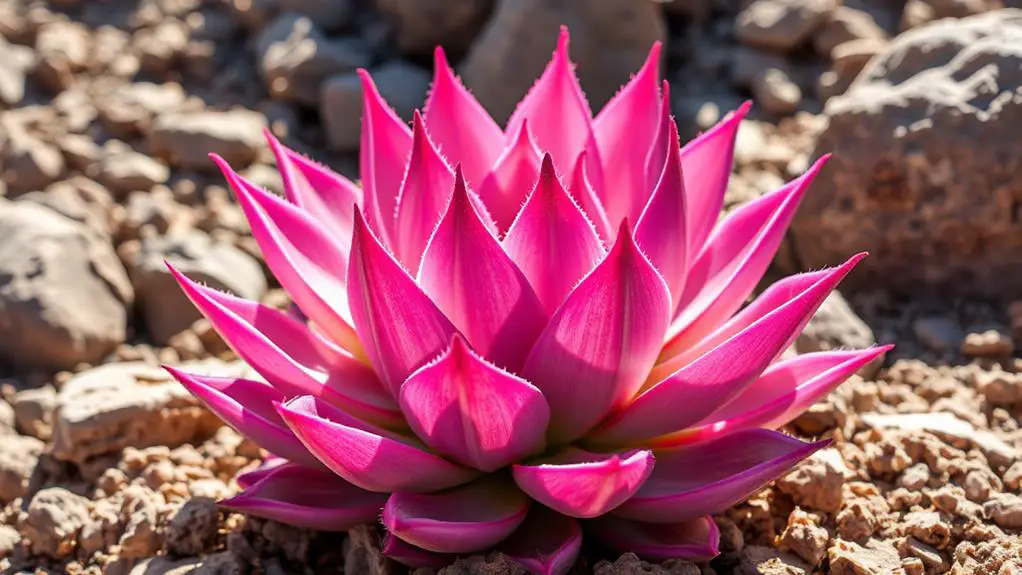
Graptoveria Fred Ives is a hybrid succulent that stands out with its stunning rosette shape and vibrant colors, shifting from green to pinkish hues under full sun exposure.
If you're looking for a plant that thrives in full sun and brings a pop of color to your garden, this is a fantastic choice. It needs at least six hours of direct sunlight daily to maintain its striking appearance and guarantee healthy growth.
Like many succulents, Graptoveria Fred Ives is drought-tolerant and requires minimal watering. This makes it perfect for low-maintenance gardens and hot climates.
Just make sure to plant it in well-draining soil to prevent root rot. It can handle temperatures ranging from hardiness zones 9 to 11, so it's quite versatile.
To keep your Graptoveria Fred Ives looking its best, monitor it regularly for pests and consider occasional fertilization during the growing season.
This will enhance its health and vibrancy. By following these simple tips, you'll find that growing this beautiful succulent is a rewarding and enjoyable experience.
With a little care, your Graptoveria Fred Ives will flourish and brighten up any sunny spot in your garden.
Euphorbia Ferox
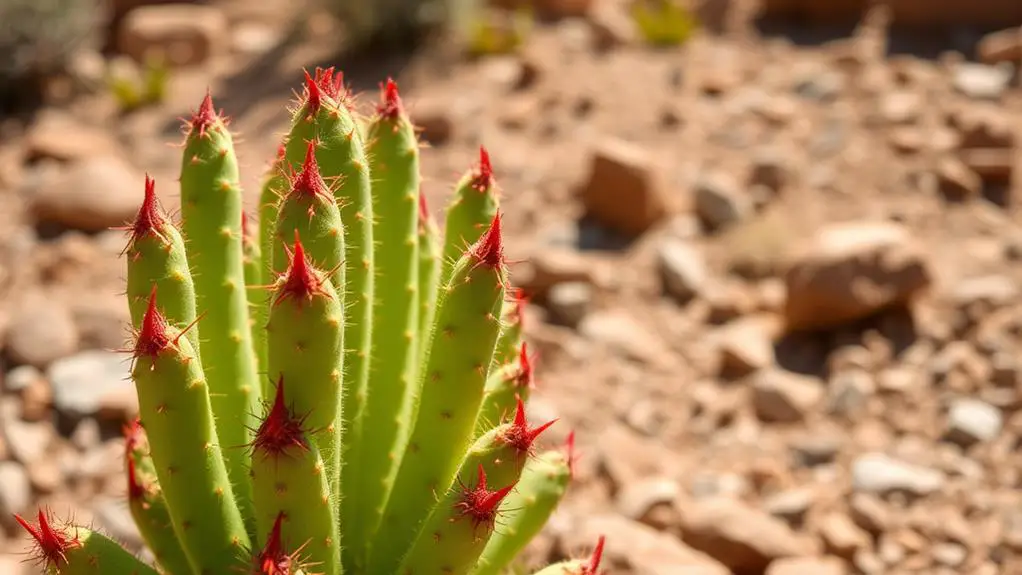
Euphorbia ferox is a great choice if you're looking for a succulent that thrives in full sun and hot, arid climates.
Its spiky, red and green stems add a dramatic touch to your garden, but remember it prefers well-draining soil and should be watered sparingly.
Let the soil dry out completely between waterings to keep it healthy and avoid root rot.
Sunlight Tolerance Features
Sunlight tolerance is a critical aspect that makes Euphorbia ferox an exceptional choice for full sun exposure. This succulent loves soaking up the sun, needing at least six hours of direct sunlight daily to thrive.
Its spiny, cylindrical structure isn't just for looks; it helps the plant minimize water loss in hot, sunny environments. Euphorbia ferox also has a waxy coating that acts like natural sunscreen, protecting it from sunburn. This feature makes it perfect for areas with intense sunlight.
You'll find it's particularly hardy in warmer zones, specifically Zones 9 to 11, making it a great fit for gardens and landscapes that get plenty of sun exposure.
Here are some key features that make Euphorbia ferox a sun-loving superstar:
- Spiny, cylindrical shape: This design minimizes water loss, helping the plant stay hydrated even in full sun.
- Waxy coating: Provides a natural barrier against sunburn, ensuring the plant stays healthy under intense sunlight.
- Drought resistance: Perfect for arid climates, it survives with minimal watering, making it low-maintenance.
Adding Euphorbia ferox to your garden means you're choosing a plant that's built to handle the sun's rays, ensuring it'll thrive in sunny spots with ease.
Watering and Soil Needs**
When it comes to ensuring your Euphorbia ferox thrives, getting the watering and soil needs right is essential. This succulent loves well-draining soil to prevent root rot. A cactus mix or a blend of potting soil with sand works perfectly. You want to make sure the soil allows water to pass through easily, keeping the roots dry and healthy.
Watering your Euphorbia ferox requires some care. It needs moderate watering, and it's important to let the soil dry out completely between waterings. This is especially important when the plant is exposed to high sunlight.
During hotter months, you might need to water more frequently, but be careful not to overwater. Too much water can cause serious problems for your plant.
Full sun can cause high evaporation rates, so keeping an eye on soil moisture is critical. Euphorbia ferox has unique adaptations like a waxy coating on its leaves, which helps retain moisture.
This means you won't need to water it as often as you might think. With the right balance of watering and soil, your Euphorbia ferox will flourish and stay healthy in full sun.
Cotyledon Ladismithiensis
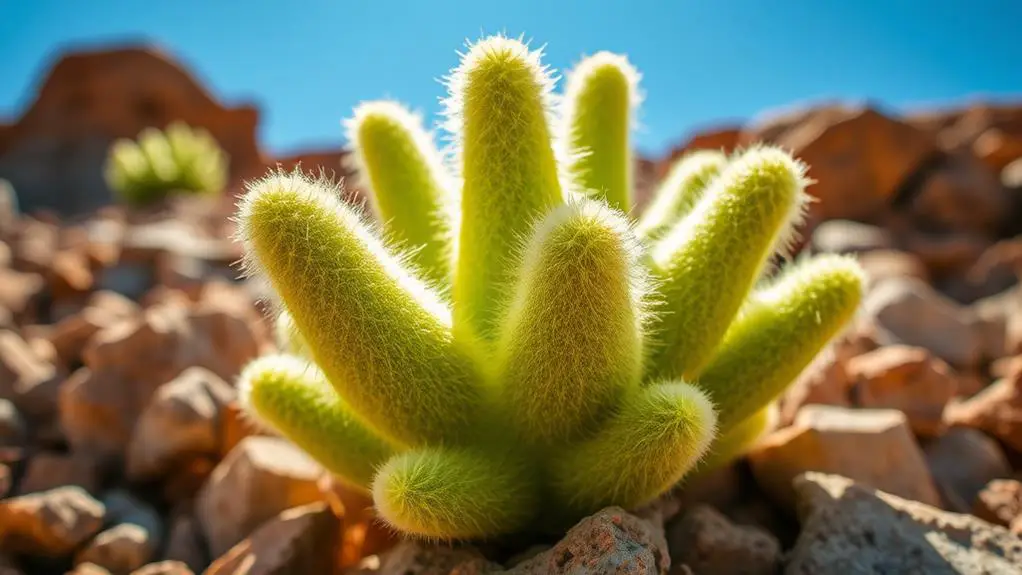
Cotyledon ladismithiensis is a fantastic choice for full sun exposure, needing at least six hours of direct sunlight each day to thrive.
Its fleshy, oval-shaped leaves can change color based on how much sun they get, turning lovely shades of green and red.
This drought-resistant succulent is perfect for low-maintenance gardens, especially in USDA Zones 9 to 11.
Sunlight Tolerance
Thriving under the sun's intense rays, Cotyledon ladismithiensis shows remarkable sunlight tolerance, needing at least six hours of direct light each day to keep its vibrant colors. You'll find that this succulent truly comes to life in full sun environments.
With its unique waxy leaves, Cotyledon ladismithiensis is well-equipped to handle the sun's intensity, effectively preventing excessive water loss.
While this plant loves bright light, be mindful of the hottest parts of the day. Too much scorching sun can still cause damage. So, if you live in a particularly hot area, consider providing a little afternoon shade.
In ideal conditions, Cotyledon ladismithiensis will reward you with robust leaves and a compact, attractive shape.
Here are some tips to confirm your succulent thrives:
- Water sparingly: Its drought-resistant nature means it doesn't need frequent watering, reducing the risk of root rot.
- Check for signs: Look for any signs of sunburn, like brown spots, and adjust its exposure if necessary.
- Rotate regularly: Confirm even growth by rotating the plant so all sides receive sunlight.
Unique Features
Beyond its impressive sunlight tolerance, Cotyledon ladismithiensis boasts several unique features that make it a standout in any succulent collection. This plant loves full sun, requiring at least six hours of direct sunlight daily to thrive. Its large leaves are fleshy and can change color based on light exposure, often turning a beautiful reddish hue in bright conditions.
One of the most striking features of Cotyledon ladismithiensis is its ability to survive in drought-prone areas. Once established, it needs minimal watering, making it an easy-care option for your garden. The leaves are covered with a powdery coating, which not only adds a unique texture but also protects the plant from sunburn and reduces water loss.
This hardy succulent is built to handle tough conditions, making it a resilient addition to your plant collection.
In the summer, you'll be delighted to see attractive, bell-shaped flowers bloom, adding a splash of color and visual interest to your garden. Whether you're a beginner or an experienced gardener, Cotyledon ladismithiensis offers a blend of beauty and hardiness that's hard to beat.
Kalanchoe Tomentosa
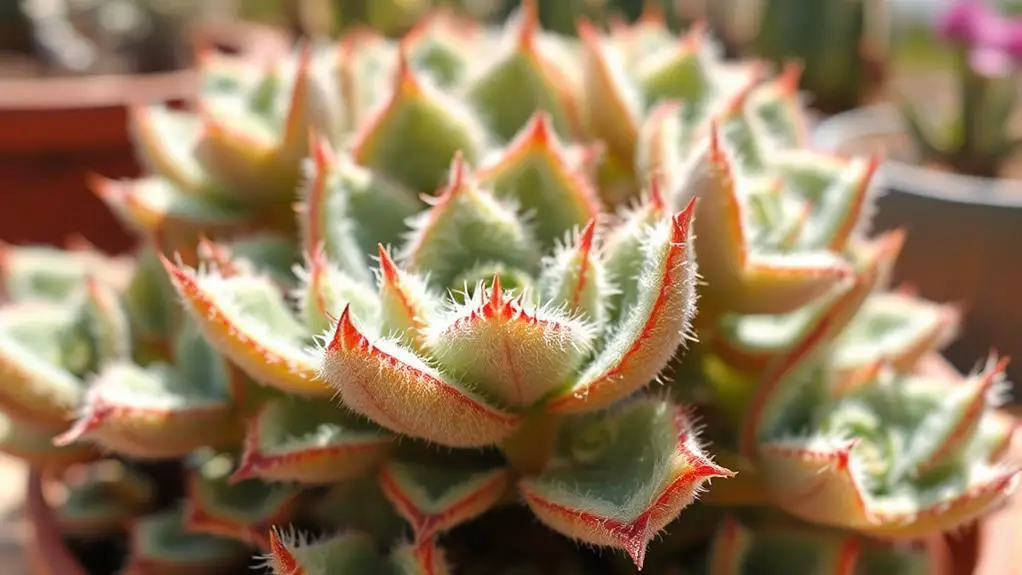
Often celebrated for its resilience and striking appearance, Kalanchoe tomentosa, commonly known as the Panda Plant, is an excellent choice for sunny gardens. This succulent thrives in full sun and can handle harsh sunlight conditions, making it perfect for bright spots in your garden.
Its fuzzy, grayish-green leaves with distinct brown margins not only help it retain moisture but also add a unique touch to your plant collection.
You'll love how low-maintenance this plant is. It requires minimal watering, allowing the soil to dry out completely between waterings to prevent root rot. This makes it an excellent option if you're looking for a plant that's easy to care for.
Here are some key points to remember:
- Full Sun: Kalanchoe tomentosa loves bright, direct sunlight and can withstand even the harshest sunlight conditions.
- Minimal Watering: Let the soil dry out fully between waterings to avoid root rot.
- USDA Zones 9 to 11: Perfect for warmer climates, but bring it indoors during colder winters to protect it from frost.
With these tips in mind, you'll have a thriving Panda Plant that adds both beauty and resilience to your garden.
Sedum Morganianum
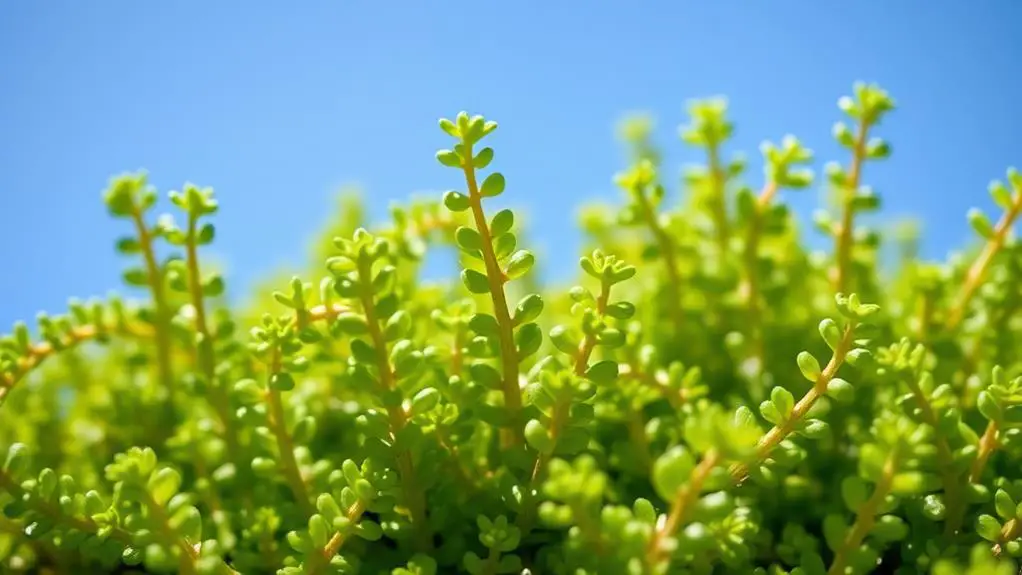
Next on our list of sun-loving succulents is Sedum morganianum, or Burro's Tail. This charming plant thrives in full sun exposure, needing at least six hours of sunlight daily. It's a fantastic choice for sunny spots in your garden or patio.
You'll love how its trailing stems, which can grow up to 2 feet long, make it perfect for hanging baskets or as ground cover in bright areas.
Sedum morganianum is incredibly drought-tolerant, so you won't need to water it often. In fact, it prefers minimal watering, making it ideal for hot climates with well-draining soil.
Its plump, bluish-green leaves aren't only delightful to look at, but they also take on a lovely reddish hue when exposed to intense sunlight, adding a touch of color to your garden.
If you have pets, you'll be happy to know that this succulent is non-toxic, making it a safe addition to your household.
Graptopetalum Paraguayense
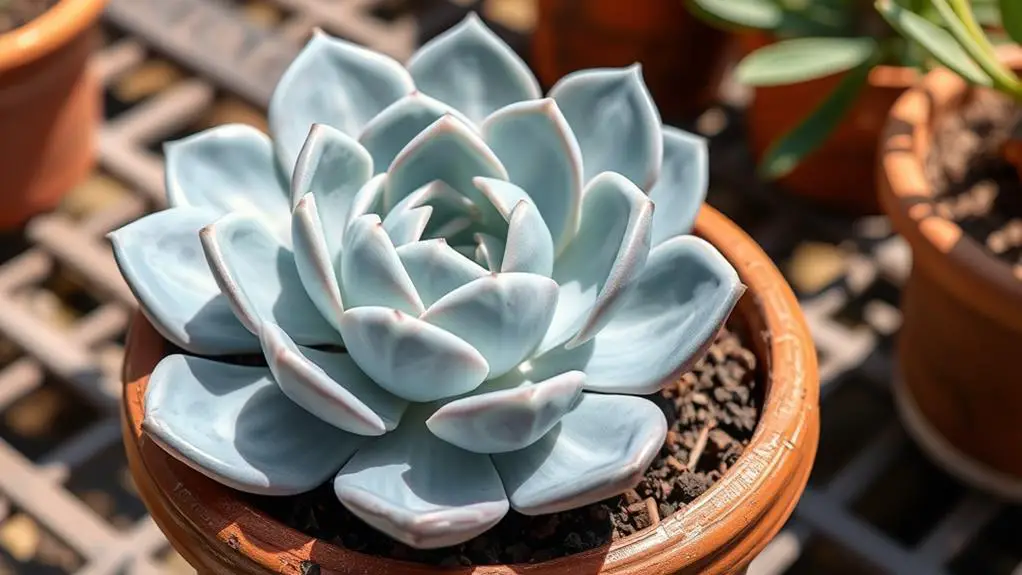
Why not consider adding Graptopetalum paraguayense, or Ghost Plant, to your sunlit garden? This lovely succulent thrives in full sun, needing at least six hours of direct sunlight each day. The bright sunlight enhances its pale blue-green leaves, giving them a charming pinkish hue.
It's a stunning addition to any garden, providing both beauty and resilience.
One of the best things about Ghost Plant is how easy it's to care for. It's drought-resistant and prefers well-draining soil, so you don't have to worry much about overwatering. In fact, too much water can lead to root rot.
Here are some key points to keep in mind:
- Full Sun Lover: Needs at least six hours of direct sunlight daily.
- Drought-Resistant: Requires minimal water, making it low-maintenance.
- Pet-Friendly: Non-toxic to pets, so it's safe for your furry friends.
Ghost Plant is hardy in USDA Zones 9 to 11, meaning it's perfect for warm climates.
Whether you're an experienced gardener or just starting, Graptopetalum paraguayense is a wonderful choice. Its striking colors and easy care make it a favorite for sunlit spaces.
Agave Parryi
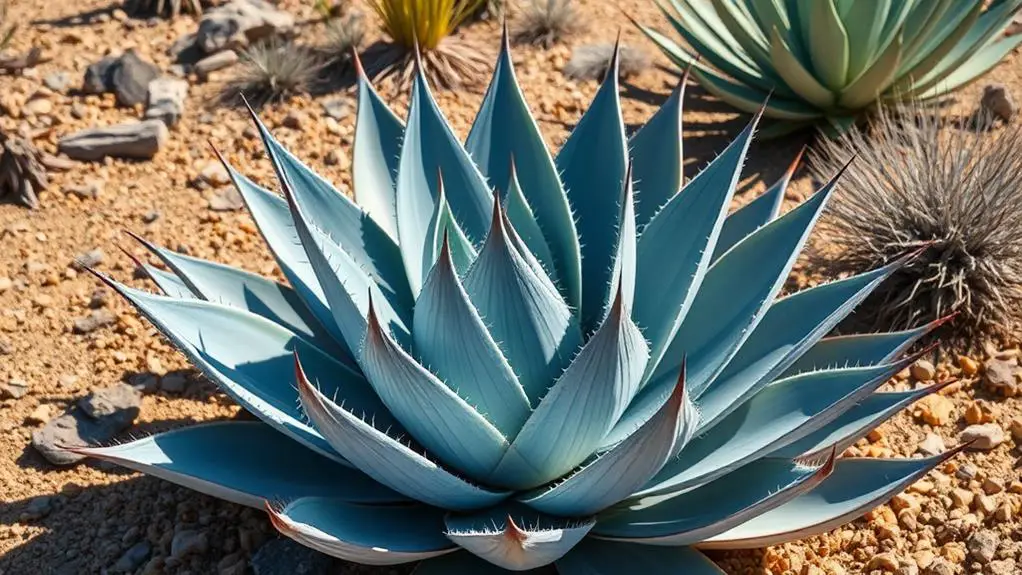
Consider adding Agave parryi to your garden for a striking and hardy option that thrives in full sun. This drought-resistant succulent loves basking in the sun, needing at least six hours of sunlight daily to grow its best.
Its spiky leaves, which can reach up to 1-3 feet tall and wide, make a bold statement in any garden. Plus, it's low-maintenance, so you won't have to spend much time caring for it.
Agave parryi is perfect for those living in USDA Zones 5 to 11, as it's tough enough to handle a range of temperatures and conditions. Over time, you'll be rewarded with long-lasting bell-shaped flowers in various colors, though flowering usually happens after several years. When it does bloom, the sight is simply stunning.
To keep your Agave parryi healthy, plant it in well-draining soil. This succulent prefers dry conditions and minimal watering, which means you don't have to worry much about root rot.
Frequently Asked Questions
What Succulents Can Be in Full Sun?
You can place succulents like Sedum morganianum, Agave parryi, Echeveria lilacina, Kalanchoe tomentosa, and Mother of Pearl in full sun. They're hardy, low-maintenance, and thrive in bright light, making them perfect for sunny spots.
Can Succulents Tolerate Hot Sun?
Yes, succulents can tolerate hot sun, but you need to gradually acclimate them to prevent sunburn. Make certain they have enough water since higher evaporation rates demand more frequent watering for ideal growth.
Can Succulents Take Full Sun Outdoors?
Yes, succulents can take full sun outdoors if you gradually acclimate them. Varieties like Sedum and Echeveria thrive in direct sunlight. Make certain they get enough water to prevent water stress due to higher evaporation rates.
Can Succulents Live in 100 Degree Weather?
Yes, succulents can live in 100-degree weather. You'll need to guarantee they're acclimated, provide occasional shade, and adjust watering frequency. Be cautious of overwatering to prevent root rot and choose heat-tolerant varieties for the best results.
Conclusion
You've got everything you need to start growing stunning succulents that love the sun. These plants, like Sedum Sediforme and Echeveria Lilacina, are perfect for bright spots and are easy to care for. Don't worry if you're new to gardening; succulents are forgiving and resilient. Just remember to give them at least 6 hours of sunlight daily, and you'll be rewarded with a beautiful, low-maintenance garden. Happy planting, and enjoy your sunny garden!

